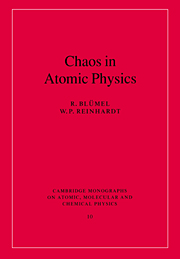Book contents
- Frontmatter
- Contents
- Preface
- 1 Introduction
- 2 Chaos: tools and concepts
- 3 Chaos in classical mechanics
- 4 Chaos in quantum mechanics
- 5 The kicked rotor: paradigm of chaos
- 6 Microwave-driven surface state electrons
- 7 The hydrogen atom in a strong microwave field
- 8 The kicked hydrogen atom
- 9 Chaotic scattering with CsI molecules
- 10 The helium atom
- 11 Chaos in atomic physics: state of the art and research directions
- References
- Index
5 - The kicked rotor: paradigm of chaos
Published online by Cambridge University Press: 14 September 2009
- Frontmatter
- Contents
- Preface
- 1 Introduction
- 2 Chaos: tools and concepts
- 3 Chaos in classical mechanics
- 4 Chaos in quantum mechanics
- 5 The kicked rotor: paradigm of chaos
- 6 Microwave-driven surface state electrons
- 7 The hydrogen atom in a strong microwave field
- 8 The kicked hydrogen atom
- 9 Chaotic scattering with CsI molecules
- 10 The helium atom
- 11 Chaos in atomic physics: state of the art and research directions
- References
- Index
Summary
In this and the following chapters we will encounter various time dependent and time independent atomic physics systems whose classical counterparts are chaotic. All the systems discussed in the remaining chapters of this book are examples of type I systems, i.e. examples for quantized chaos. This is natural since quantized chaos is by far the most important type of quantum chaos relevant in atomic and molecular physics. In the category “time dependent systems”, we discuss the rotational dynamics of diatomic molecules (Section 5.4), the microwave excitation of surface state electrons (Chapter 6), and hydrogen Rydberg atoms in strong microwave fields (Chapters 7 and 8). All these systems are driven by externally applied microwave fields. For strong fields none of these three systems can be understood on the basis of quantum perturbation theory, as the involved multi-photon orders are very high. Processes of multiphoton orders 100 to 300, typically, have to be considered. It is important to realize that in this day and age, with powerful super-computers at hand, there is no problem in implementing a perturbation expansion of such high orders. But the emphasis is on understanding the processes involved. Although multi-photon perturbation theory provides valuable insight into the physics of low order multi-photon processes important in the case of weak applied fields (an example is discussed in Section 6.3), not much insight is gained from a perturbation expansion that has to be carried along to the 100th order and beyond in order to converge.
- Type
- Chapter
- Information
- Chaos in Atomic Physics , pp. 117 - 149Publisher: Cambridge University PressPrint publication year: 1997



